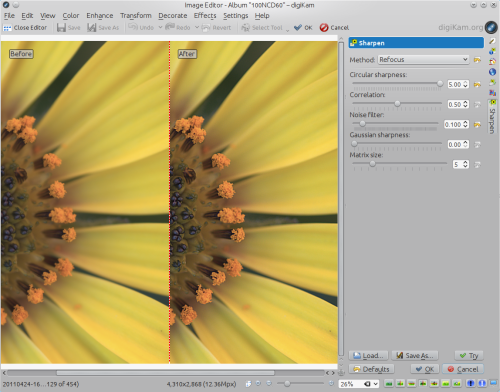Digikam/Sharpening/ca: Difference between revisions
Created page with "Category:Gràfics/ca Category:Fotografia/ca Category:Guies d'aprenentatge/ca" |
Created page with "L'eina Definició al digiKam ofereix tres mètodes de definició: definició senzilla, màscara de suavitzat i reenfoc. Cada mètode té els seus avantatges i inconvenients. L..." |
||
| Line 3: | Line 3: | ||
Transcrit des de l'article d'en [[User:Dmitri Popov|Dmitri Popov]], el 8 de maig de 2013 | Transcrit des de l'article d'en [[User:Dmitri Popov|Dmitri Popov]], el 8 de maig de 2013 | ||
L'eina Definició al digiKam ofereix tres mètodes de definició: definició senzilla, màscara de suavitzat i reenfoc. Cada mètode té els seus avantatges i inconvenients. La tècnica de definició senzilla utilitza un algoritme de matriu de convolució estàndard per millorar els detalls de la imatge. Si sou curiós quant a l'essencial i bàsic de la matriu de convolució, la [http://docs.gimp.org/en/plug-in-convmatrix.html documentació de GIMP] proporciona una breu descripció de l'algorisme. De fet, l'eina de definició senzilla al '''digiKam''' és un port pel projecte '''GIMP'''. El principal avantatge del mètode de definició senzilla és la seva simplicitat. L'eina de definició senzilla al '''digiKam''' només té un paràmetre ajustable anomenat <menuchoice>Definició</menuchoice>, el qual determina la força del filtre de definició aplicat. El desavantatge, el mètode de definició senzilla no maneja gaire bé el soroll de la imatge: tendeix a introduir més soroll en les fotografies preses amb ajustos ISO baixos. | |||
<menuchoice>Unsharp mask</menuchoice> is a popular sharpening method which sharpens the edges of the elements without increasing noise. The unsharp mask technique creates a slightly blurred version of an image, which is then subtracted from the original in order to detect edges. The resulting mask is then used to increase contrast along the detected edges to produce a sharper final image. The Unsharp Mask tool in '''digiKam''' has three adjustable parameters: | <menuchoice>Unsharp mask</menuchoice> is a popular sharpening method which sharpens the edges of the elements without increasing noise. The unsharp mask technique creates a slightly blurred version of an image, which is then subtracted from the original in order to detect edges. The resulting mask is then used to increase contrast along the detected edges to produce a sharper final image. The Unsharp Mask tool in '''digiKam''' has three adjustable parameters: | ||
Revision as of 18:36, 9 May 2013
Definició al digiKam
Transcrit des de l'article d'en Dmitri Popov, el 8 de maig de 2013
L'eina Definició al digiKam ofereix tres mètodes de definició: definició senzilla, màscara de suavitzat i reenfoc. Cada mètode té els seus avantatges i inconvenients. La tècnica de definició senzilla utilitza un algoritme de matriu de convolució estàndard per millorar els detalls de la imatge. Si sou curiós quant a l'essencial i bàsic de la matriu de convolució, la documentació de GIMP proporciona una breu descripció de l'algorisme. De fet, l'eina de definició senzilla al digiKam és un port pel projecte GIMP. El principal avantatge del mètode de definició senzilla és la seva simplicitat. L'eina de definició senzilla al digiKam només té un paràmetre ajustable anomenat , el qual determina la força del filtre de definició aplicat. El desavantatge, el mètode de definició senzilla no maneja gaire bé el soroll de la imatge: tendeix a introduir més soroll en les fotografies preses amb ajustos ISO baixos.
is a popular sharpening method which sharpens the edges of the elements without increasing noise. The unsharp mask technique creates a slightly blurred version of an image, which is then subtracted from the original in order to detect edges. The resulting mask is then used to increase contrast along the detected edges to produce a sharper final image. The Unsharp Mask tool in digiKam has three adjustable parameters:
specifies how many pixels on either side of an edge will be affected by sharpening. High-resolution photos allow higher radius.
determines the strength of sharpening.
specifies the minimum difference in pixels that indicates an edge where sharpen must be applied. This lets you protect areas of smooth tonal transition from sharpening, and avoid creating blemishes in face, sky or water surfaces. [1]
When using the unsharp mask tool, you should keep in mind that it can introduce subtle color shifts and halo artifacts visible as dark or light outlines near edges.

Finally, the method is based on the Refocus plugin for GIMP which uses a technique called FIR Wiener filtering to sharpen the image (see http://en.wikipedia.org/wiki/Wiener_filter). Similar to the original plugin, the Refocus tool in digiKam offers several adjustable parameters:
is a key parameter which determines the radius of the circular convolution. Basically, it specifies the strength of the refocusing action.
helps to reduce artifacts. Increasing the correlation value reduces the sharpening effect. Useful values are 0.5 and values close to 1 (e.g., 0.95 and 0.99).
may help to reduce artifacts. Similar to the Correlation parameter, increasing the noise filter value reduces the sharpening effect. A useful value is 0.01.
is used to specify the radius of the Gaussian convolution for correcting Gaussian blur. In most cases, it should be set to 0, as it introduces artifacts. When using non-zero values with Gaussian sharpness, you might need to increase the Correlation and Noise filter parameters, too.
determines the size of the transformation matrix. Increasing this parameter may give better results, especially when large values are chosen for the Circular sharpness or Gaussian sharpness parameters. In most cases, you should select a value in the range 3-10. [2]
is the most powerful and effective sharpening tool in digiKam’s arsenal, as it not only offers a superior sharpening method and granular controls, but can also handle noise.
[1] Font: http://docs.gimp.org/en/plug-in-unsharp-mask.html
[2] Font: http://refocus.sourceforge.net/
